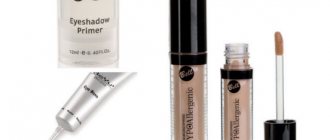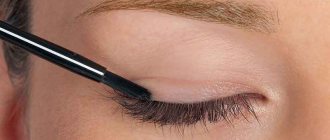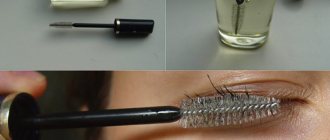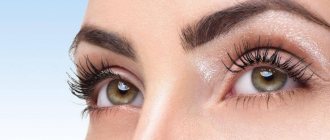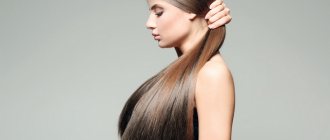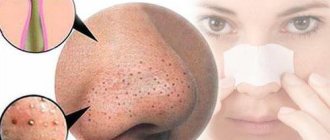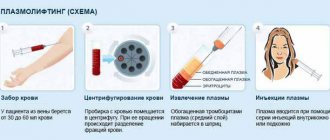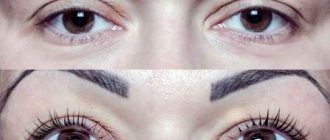Nail modeling is a complex and meticulous procedure that requires special preparation of the nail plate. To work with nails, several types of products are used, which serve as the foundation for applying acrylic and gel coatings. One such coating is a primer. Everyone who decides to paint their nails should know what it is and why it is needed.
Nail primer: what is it?
A novice manicurist needs to know what a nail primer is. Any material is needed for something, serves certain purposes. Translated, the name of this product means “initial”, “first”. It is used to remove the greasy layer, clean and dry the plate area, which helps to evenly distribute subsequent layers of cosmetics.
Primer composition
The consistency of the primer is similar to ordinary water or gel. Sometimes it has a smell similar to vinegar, but sometimes it is odorless.
Primers are divided into two classes:
- acid;
- acid free.
The product is sold in glass or plastic bottles with a cap on which a brush is attached. The composition of ingredients does not contain unnecessary colors and flavors to reduce the likelihood of allergies.
Acid based primer contains methacrylic acid (30% to 100%). It promotes adhesion of the nail structure to the applied materials. This product is often used when applying acrylic to the nail. In addition, the composition contains chemical components such as ethyl acetate and 2-hydroxyethyl methacrylate.
Ethyl acetate has a pleasant fruity aroma, softens the skin and serves as a solvent. These substances affect the quality and effectiveness of the composition. Acid is very drying, so it is recommended to use a product based on it on oily and upward-growing nails.
A distinctive property of the primer is quick drying. It leaves a pale gray residue once it has appeared, which means the next coat is ready to be applied. When interacting with the skin, it can cause an allergic reaction, expressed in hyperemia and irritation.
A primer that does not include acid is safer, but is inferior in terms of adhesion. Professionals recommend choosing it if you are performing a manicure with gel polish.
Why do you need a primer for eyelash extensions?
The primer acts as a kind of “primer”, that is, it ensures reliable adhesion of the glue to the hair. Only instead of forming a rough layer on the surface of the eyelash, the primer itself makes it rough.
The primer contains alkalis or acids (depending on the main active component, alkaline and acidic primers are distinguished). Their main task is to open the hair scales, “ruffle” them, thereby providing a rough surface. Thus, the glue will reliably fix the artificial hair on the natural one, eliminating the possibility of falling off. One bottle of Bombini primer is enough for 200-250 procedures.
In recent years, many “2 in 1” products have appeared on the market, which simultaneously degrease natural hairs and open their scales. However, since the drugs themselves perform different functions, for more effective action it is recommended to use a degreaser and a primer separately.
How does a bonder differ from a primer?
It is not enough to know what a nail primer is to perform a manicure at a professional level. For proper extension you will also need a bonder. It is used to treat the nail before applying a coating with decorative properties.
The bonder determines the strength of the connection between the nail and this coating. It helps to create a solid base and make the work high-quality and durable. The primer prepares the work surface for uniform application - that's what it's for.
Bonder guarantees high-quality grip. It does not contribute to degreasing, disinfection and dehydration, but creates a protective film on the surface.
The bonder has a sticky texture and, after application, dries under a lamp for about 3 minutes. Used after the primer.
What is a nail primer for?
Nail primer is an important element that must be used to create a perfectly smooth and grippy finish. It helps to quickly dry the nail plate, removes unnecessary fat from its surface, which prevents the perfectly even and smooth application of gel polishes or extension gels.
The primer is used at the very beginning of the procedure, after finishing the manicure. It is characterized by a liquid consistency, dries in a matter of seconds, creating a light light shade on the surface of the nail plate. Its use is considered mandatory to create a strong and durable manicure.
Types of primers
Pre-primer is a delicate product with protective functions. Some call it bond. It does not contain coloring or flavoring components, it is gentle on the nail and does not penetrate into the inner layer. Prep degreases well.
When doing extensions, it is often applied before acidic products in order to remove the fatty layer well. With prolonged use, it does not dry out or make nails brittle.
The primer helps the nail not to flake or turn yellow.
Prep cannot be used for extensions, because it gives weak adhesion.
Application:
- as a base for traditional varnish;
- as a protective agent for damaged nails;
- a product that promotes additional adhesion of the nail to the upper artificial layers (especially important for people suffering from hyperhidrosis);
- with intolerance to artificial materials.
Acid primer is intended for procedures with healthy nails. It softens the nail, which improves adhesion. It is forbidden to apply it to weak, diseased and brittle nails, as it is toxic. It is not recommended to apply the product liberally or several times in one procedure. Often used for extensions using acrylic-based materials.
An acid-free primer (ultrabond) has a neutral and gentle effect on the natural structure, but performs the same tasks. The product is more suitable for removing fat and dehydration. It is used both under gel and for pedicure and manicure with bio-varnish.
General characteristics of the product
Primer (from the Latin word “prime” - first, primary) should be applied to the nail as a base coat. Its constituent components:
- protect nails from mechanical damage and microbial infections,
- degrease the nail plate, removing natural fatty lubricant;
- provides better adhesion to the coating material.
The disinfecting effect is extremely necessary at the initial stage of manicure. Bacteria trapped between the nail plate and the artificial coating can cause unwanted inflammatory processes in the nail, as well as provoke separation of it and the coating. With the help of this manicure component you can combat unwanted defects of the nail plate - stripes, spots, tubercles. It is very convenient that the primer also has a dehydrating property (removing excess liquid for high-quality adhesion of the coating to the nail). Thus, it is also a nail dehydrator.
The product exhibits a fairly strong disinfectant and dehydrating effect only in the upper layers of the nail, without destroying it or changing the water balance or other indicators of moisture.
It doesn’t matter what exactly the master will do next - gel polish, shellac or acrylic extensions, first of all the nail plate is covered with a base layer. There are currently three types of primers:
- pre-primers,
- acid-free;
- acidic.
The best companies
What is a nail primer and why it is needed is now clear, all that remains is to review popular products.
Lady Victory acid-free primers perfectly degrease, provide reliable adhesion and prevent peeling of the coating. Ideal for beginner manicurists due to the absence of acidic substances in the composition. Price range from 80 rub. up to 350r. Manufacturer – China.
Le Vole Ultra Bond is ideal for working with gel and acrylic. The compositions of this brand disinfect and clean the nail well, while maintaining the natural pH level. Price range from 250 rub. up to 400 rub. Manufacturer – USA.
Kodi Professional Ultrabond has a gentle composition, without methacrylic acid. Used when working with gel and for acrylic extensions. Average price – 450 rub. Manufacturer – USA.
EZ Flow produces products without dyes or fragrances. The brand's primer dries quickly, leaving a white residue. The brand produces all types of materials for working with different nail coatings. Production - USA. Price range from 500 rub. up to 1100 rub.
IBD has been known on the market for over 30 years. The brand produces products suitable for people with hyperhidrosis and very brittle nails. IBD stick contains methacrylic acid, which prevents peeling of materials. Product cost from 300 rub. up to 900 rub. Manufacturer – USA.
Runail Professional Primer Acrylic System produces a product for acrylic extensions. Has excellent adhesive ability. Manufacturer – Russia. Price from 200 rub.
Yoko APR-15 is suitable for both gel and acrylic. This primer is acid based and its adhesive properties are significant. Price 150 rub. Manufacturer – Russia.
TNL Professional is also used for strong adhesion of nail and extension materials. The brand produces both primers with and without acid. Cost - from 180 rub. up to 240 rub. Production - South Korea.
Bluesky reduces the likelihood of coating peeling and increases adhesion. It is combined with both gel and acrylic, and is also used when coating with gel polish. There is no methacrylic acid among the ingredients. Price range from 140 rub. up to 250 rub. Production is located in China.
Irisk is a professional gel-free primer. Produces products for acrylic and gel.
Price range from 150 rub. up to 440 rub. Made in the USA. Available in bottles with volumes from 10 ml to 15 ml. The brush is usually included.
Allergy to gel polish. The composition of gel polish and what does it contain?
Allergy to gel polish is a problem that nail service professionals often encounter. What components in gel polish can cause allergies? We tell nail technicians about the chemistry of materials and allergenic components in gel polish.
What does gel polish contain?
What components in gel polish can cause an allergic reaction?
Are there hypoallergenic gel polishes?
Monomers and oligomers
Substances whose molecules are capable of polymerizing with each other to form a polymer. Such a polymer is a gel polish coating. On the label you can see the names of monomers such as Hydroxyethyl Methacrylate and Hydroxypropyl Acrylate.
Photopolymerization initiators
For example, a substance such as Hydroxycyclohexyl phenyl ketone is a photoinitiator, that is, it actively absorbs ultraviolet rays and starts the polymerization reaction. Different manufacturers include different percentages of this substance in their products, so the higher the content, the faster the gel polish polymerizes.
Solvents
Reaction solvents for oligomers that enable the polymerization process. Such solvents include Isobornyl Methacrylate.
Pigments
Can be natural or synthetic. In colored gel polishes, pigments are most often designated like this: CI 15850, which means that a synthetic red dye “Ruby lithol BK” was used.
Fragrance
Just like pigment, it can be natural or synthetic. It can be found in its composition as “ethyl acetate”, then the gel polish acquires a fruity aroma
What components in gel polish can cause an allergic reaction?
An allergic reaction can occur to any component in gel polish, but one of the most common causes of allergies is the sticky layer. The dispersion layer is the remnant of non-polymerized gel polish and contact with it should be minimized or eliminated. In addition, sometimes substances are used in production that increase the risk of an allergic reaction.
Formaldehyde
A preservative, which is used in the production of cosmetics to preserve its shelf life, actively fights bacteria and moldy fungi. The substance is allowed to be used in nail products, but do not allow contact with the skin.
Synonyms on the label can be: formalin, formic aldehyde, merthaldehyde, methanal, methyl aldehyde, oxomethane, oxymethylene, aldehyd mravenci (czech), aldehyde formique (French), aldeide, formica (italian), bfv.
Toluene
It is used as a solvent in varnishes and is a toxic component. In production, toluene is used in very low concentrations and in a limited range of products.
Synonyms on the label can be: benzene, methyl, benzene, methyl-, methyl-benzene, methylbenzene, toluol, antisal 1a, benzene, methyl-, cp 25, methacide, methane, phenyl-, methylbenzene.
Dibutyl phthalate
A plasticizer that protects the coating from cracking. Its vapors can cause irritation of the mucous membrane of the respiratory system.
Synonyms in the composition can be: 1,2-benzenedicarboxylic acid, dibutyl ester, butyl phthalate, dbp, di-n-butylphthalate, dibutyl 1,2-benzenedicarboxylate, dibutyl ester 1,2-benzenedicarboxylic acid, dibutyl phthalate, dibutyl phthalate, dibutyl phthalates, benzene-o-dicarboxylic acid di-n-butyl ester, celluflex dpb, dbp (ester).
Methylisothiazolinone
Used in cosmetics to increase their shelf life.
Synonyms in the composition can be: 2-methyl-3 (2h) -isothiazolone, 2-methyl-2h-isothiazol-3-one, 2-methyl-3 (2h) -isothiazolone, 2-methyl-4-isothiazolin-3- one, 3 (2h) -isothiazolone, 2-methyl-, 3 (2h) isothiazolone, 2methyl, methylchloroisothiazolinone, methylisothiazolinone solution, 2-methyl-3 (2h) -isothiazolone, 2-methyl-4-isothiazolin-3-one.
All substances that are used in gel polishes require compliance with safety precautions when working with them. Therefore, you should not neglect protective measures when applying gel polish or nail extensions and be sure to work with a mask and gloves.
Are there hypoallergenic gel polishes?
Manufacturers often indicate formulas 3-free, 5-free, 7-free and 9-free on hypoallergenic products. They involve avoiding toxic preservatives, plasticizers, petroleum products and various allergens.
3-Free
Gel polishes with this mark do not contain three toxic ingredients: formaldehyde, toluene and dibutyl phthalate (DBP).
5-Free
In addition to the three components listed above, these gel polishes also contain no formaldehyde resins or camphor. Resin and camphor are strong allergens. 5-Free gel polishes include the Uno Lux base coat and the RIO Profi hypoallergenic rubber base.
7-Free
Such gel polishes do not contain substances harmful to health: formaldehyde, formaldehyde resins, toluene, dibutyl phthalate, camphor, xylene and ethyltosilamide. Gel polishes with this formula include the CND brand.
9-Free
Gel polishes are free of dibutyl phthalate, formaldehyde, formaldehyde resin, toluene, parabens, camphor, methylisothiazolinone, hexylcinnamaldehyde and fragrance. A rubber base coat with a 9-free formula was released by the ONIQ brand in volumes of 10 and 30 ml.
Anyone can develop an allergy to gel polish, even to hypoallergenic products, so you should carefully follow the procedure for gel polish and nail extensions. Read in this article what to do at the first signs of an allergy and how to recognize it.
Source: https://imkosmetik.com/journal/allergiya-na-gel-lak-sostav-gel-laka-i-chto-v-nego-vhodit/
Primer for gel polish and shellac
What a nail primer is and why it is needed has already been explained, and from this it becomes clear that its use is mandatory.
The product disinfects and removes excess moisture from the nail plate, which saves from various fungal diseases, because if a humid environment forms under the material, this will promote the development of pathogenic bacteria. The primer also increases the service life of the decorative coating.
Experts recommend using an acid-free product under shellac, so your nails will remain healthy after the manicure is removed.
Before using gel polish, the primer can be neglected if the client has dry and non-greasy nails. If a client suffers from hyperhidrosis, applying primer is a necessary ritual. It is also recommended to additionally protect nails that are brittle.
Acidic or acid-free
The first to create an acid-free primer, and in 1988 they released an acid primer. Both products prepare the nail for coating equally well, but the second type can burn the skin and tissue of the nail plate.
This is not to say that acid-free primers do not contain acid at all. They simply do not contain methacrylic acid, but do have solvent-based substances. They are not as harsh or harsh on the skin as methacrylic primers. But even despite this, the use of acid has a more gentle effect than an abrasive file.
Primer for regular varnish
This product can also be applied under regular varnish. It will serve as a primer layer, level the working surface of the nail and protect it from the penetration of chemicals. For those whose hands sweat a lot, the primer is a godsend. Under regular varnish, you can use a primer that does not contain acid.
Some manufacturing companies purposefully produce primers not only for gel and acrylic, but also for traditional varnish. For example, this is Yang nails with its acid-free product – Protein Bond. In tandem with varnish, you can also use a base coat.
Facial primer: what is it?
The English word prime in translation means “primary, main, main”. Primer is a base for your future makeup, which should be applied before any other products.
This word has another meaning: to prime - “to prime.” That is, in fact, it is a primer on which the actual decorative cosmetics are applied. This product can be without a tinting effect or with a slight tint.
In addition, the primer can be of different textures - liquid (like silicone fluid) or dense matting (like mousse or cream powder).
Primer for gel nail extensions
The gel has large molecules, and they cannot adhere well to the nail scales. The primer fills in the unevenness of the keratin fibers. For gel modeling, you can purchase an acid-free product. Experts advise applying it in two layers when applying extensions to tips or forms.
The tips must be handled carefully; it is important that the product does not get on them, otherwise they will crack. The primer can be used for correction, but it can only be applied to a regrown nail. Contact with skin or artificial turf must be avoided.
Manicure stages and possible mistakes
Today there are 3 main types of manicure:
- hardware;
- combined;
- classical.
Combined and hardware manicure must be done using a special manicure apparatus, but before using it, it is better to undergo training, since improper operation of the apparatus can lead to damage to the nail plate, for example, cuts. For beginners, it is better to do a classic manicure at home.
Before applying gel polish, you need to put your nails in order: treat the cuticle, file the shape.
How to use nail primer - step by step instructions
What a nail primer is and what it is needed for, a true professional knows very well and actively uses it in his work. But even a beginner, after studying the instructions, can master the correct application technique, and then it will bring the desired results.
- First, a regular manicure is done and the cuticle is pushed back. A warm bath is pre-prepared. Next, you need to remove the glossy shine with a buff. Do not remove too much, otherwise you may damage and weaken the plate. Dust is removed with a brush. Now apply the primer.
- A small amount of product is collected; excess liquid can be removed with a napkin or brushed from the brush into the bottle.
- The brush is placed in the center of the nail plate, you need to let the primer spread. A thin layer is applied, and the nail should be touched pointwise. Areas should not be left untreated. But an abundant layer will lead to the opposite effect, the nail scales will close.
- If the primer gets on the skin, you must carefully and carefully remove the product with a napkin or rinse the area under running water.
- The drying stage remains. There are several options: naturally, in a UV or LED lamp. Information on use can be found on the bottle or in the instructions. An acidic primer, when dried, gives a pale gray coating; an acid-free primer should dry well and not leave wet marks. The surface becomes rough to the touch.
- Now you can distribute the decorative coating.
- When applying gel extensions, the primer is applied before applying the base coat. If the system consists of three phases, then this will be the first layer. If this is a single-phase system, then the first layer is applied differently.
- The brush should be half dry, apply the product using rubbing movements. Then the gel is distributed and the hand is placed in the lamp.
- If tips are used, then a primer is also applied before the bonder.
- The system is as follows: first, degreasing is done with ultrabond, then a thin layer of acid-free product is applied and glue is applied.
- After application, the primer retains its active properties for 40 minutes, so it is recommended to apply it to 2-3 nails in stages.
Primer types
Nail primers are divided into 2 groups:
- Self-curing. These adhesives harden chemically. The mixture hardens on its own. There is no need to dry them in a lamp. One excellent example is the Bluesky line primer. Until now, only positive reviews have been heard about it and the price is quite reasonable.
- Light-curing. This primer is dried in a special lamp.
Most modern nail primers are self-curing.
Should I dry the primer in a lamp?
There are self-curing and light-curing primers.
Self-curing nail primers dry quickly. Everything is individual, depending on the manufacturer and the intensity of the product - on average from 5 to 60 seconds. There is no need to dry them in a lamp.
Some manufacturers produce products that are dried in a UV lamp. This is usually indicated in the accompanying information. Such primers have a thick and viscous texture, while others are liquid, like water.
It is important to follow the duration of exposure in the lamp indicated on the product, otherwise you can harm your nails. Some primers take a long time to dry.
The main thing is not to apply the next layer until the primer has dried.
Don't miss the most popular article in the section: How to extend nails with gel polish. Nail extension instructions for beginners. Photo.
How long does it take for primer to dry?
After applying the primer, many wait for a second effect and immediately proceed to apply gel polish or gel for nail extensions. It is not right! The primer dries on the nails from 20 to 60 seconds, everything is individual. To ensure the full effect of the primer, you must wait this time, make sure that the nail plate is thoroughly dry and ready to apply the main products.
You only need to check the dryness level of the primer visually; touching the nail plate with your fingers or objects is prohibited!
It is impossible to say exactly how long it takes for the primer to dry on your nails; you just need to focus on the time of 60 seconds, and only after that proceed to applying gel polish. If the nails are not dry enough and a base is applied on top, the effect of the primer will be completely canceled.
Professional recommendations for working with primer
What is a nail primer and why it is needed should now be clear.
But it remains to learn a few more tips from the masters of the manicure industry:
- If the master has injured the cuticle and started bleeding, and there is no hemostatic agent on hand, you can use a primer, but there will be a strong burning sensation.
- If too much product is applied, the client may experience 3rd degree burns.
- Before applying the finishing layer, you can lightly walk the cuticle with the product. This will get rid of microcracks and detachments, and your nails will look good until the next extension.
- When using an acid primer, the periungual skin can be lubricated with a rich cream. This will protect against possible irritation and burning.
- You should avoid getting the primer on the tips during extensions.
- The product should be applied with a brush.
- If the nails are too elastic, apply an acid-based product along the end part and the free edge, and the rest with ultrabond.
How can I replace primer for gel polish?
If you know what a nail primer is, you can find a replacement for it. However, not many people know why it is needed. Homemade options can only dry and disinfect the surface being treated; adhesive properties cannot be achieved.
Vinegar (9%) removes remaining grease and promotes the evaporation of excess moisture, but it does not lift the nail scales and therefore does not increase the tenacity of the materials. Boric acid (3%) has antiseptic properties and slightly increases tenacity, but only a gel will do.
Nail polish remover, if it does not contain acetone, will dry your nails and increase their adhesive properties. You can work with it instead of a primer only if the composition does not contain oils.
Nail primer can be replaced with nail polish remover.
In addition, you can wash your hands thoroughly with laundry soap. This will help remove the oily layer, but the skin on your hands will suffer. 96% pure alcohol or lemon juice will do. All of the above options are applicable, but will not give a significant effect, such as that provided by a special product.
The primer protects your nails from diseases and allows you to prolong the joy of a first-class manicure. Nail art beginners need to learn in detail what a nail primer is, how to choose it according to the task, what it is for and how to use it.
What is a degreaser for extensions?
You already know for sure that the extension procedure involves fixing an artificial hair or tuft on each individual natural eyelash using special glue. Our eyelashes are in close contact with the skin of the eyelids, and it, like in any other place on the body, secretes sebum - a fatty secretion that forms a protective layer on the surface and retains moisture. Sebum also settles on the eyelashes, lubricating them at the roots and providing natural protection and hydration. But fat does not allow the glue on eyelash extensions to adhere well to the natural hair, so it must be removed.
In this case, a special eyelash degreaser does the job perfectly. In addition to sebum, it effectively removes the remnants of caring cosmetics (creams and serums often contain oils), keratinized particles of the epidermis, dust, remnants of decorative cosmetics and other contaminants. On a cleaned eyelash, the extension glue lays down in an even, smooth layer, dries faster and fixes the artificial hair more firmly.
Also, a wide degreaser is used for lamination of both eyelashes and eyebrows, as well as before coloring them. It prepares hair well for the application of strengthening composition or dye, so nothing interferes with penetration, and the effect is more pronounced and of higher quality.
Many beginning craftsmen decide to skip the degreasing step because they want to save time and money. In terms of lost time, degreaser treatment takes no more than 20 seconds, and drying takes 40 seconds, so this minute delay is not significant. It is better to spend some money on eyelash degreaser than to lose a potential regular customer and, accordingly, possible earnings. In addition, without degreasing, the extension process itself will last much longer - the artificial hairs will not lie smoothly, they will constantly shift and attach poorly. Even if the specialist, after spending many precious minutes on extensions, copes with the task, the extensions will fall off very quickly (and they will fall off on their own, and not along with natural eyelashes in the process of their natural renewal), and the result will not look very beautiful.
In addition, many newcomers to the field of lash making try to replace the degreaser with a regular makeup remover. This is a big mistake because:
- eyelash degreaser removes not just the remains of decorative cosmetics, but also sebum, dust and other contaminants;
- makeup remover performs only its immediate function, and often simply does not cope with removing the fatty layer from eyelashes;
- Makeup removers often contain oils and waxes, which only make the situation worse.
It is also important to mention that eyelash extension degreaser has antiseptic properties. When the field of lash making was just beginning to develop, and degreasers did not yet exist in principle, masters used chlorhexidine, a common and safe antiseptic that can be bought at any pharmacy.
Regardless of the manufacturer, eyelash degreasing products almost always contain three main components:
- water – approximately 70% by volume;
- ethanol is an alcohol that dissolves fat and other contaminants;
- allantoin – gives natural hair elasticity and firmness, due to which artificial eyelashes are more firmly fixed.
Eyelash degreasers have their own expiration dates, which usually range from 9 months to a year . You can extend the shelf life by choosing a product in a bottle with a narrow spout - less air gets into the container.
Despite the strict need to degrease eyelashes before extensions, the product completely prepares the hairs for the procedure. In order for the glue to adhere tightly to the natural hair, its surface must be rough. It is for these purposes that a primer is used in the field of extensions.
Useful videos on choosing and using nail primer
Which primer should beginners choose: acidic or acid-free:
Subtleties of using nail primer:
It is impossible to imagine beautiful well-groomed nails without a stylish original manicure. Every girl or woman strives to give herself a chic image with the help of a bright coating of nail plates. In most cases, nails have to be extended. Artificial nails require special care, but rarely does anyone know what products are needed for this and how to use them. One of these drugs is a primer, without which it is impossible to imagine proper care.
Recommendations for use
Applying primer to the face is quite simple: you can understand the technology of operation after the first 2-3 uses of the product.
However, you cannot ignore important application rules, with the help of which you can avoid negative consequences or poor-quality results: [/vc_column][/vc_row]
[vc_empty_space height=”20"]
Primer action
First you need to understand what a primer is. This is a colorless liquid and is indispensable for nail extensions. Before applying it, the nail plates must be processed using a sanding file and given the desired shape.
The primer strengthens the gel after application and prevents it from peeling off. Artificial turf lasts longer and lasts longer. Many girls use a simple nail polish remover to degrease. A primer will also come to the rescue here; it perfectly disinfects and degreases the nail plates.
After washing your hands or special baths before a manicure, you should also use a primer; it will do a good job of removing dirt and preparing your nails for application. It can be either gel polish or simple polish.
There are three types of primers:
- acid-free (excellently cleanses, dries, an indispensable assistant for gel extensions);
- acidic (in most cases used for acrylic extensions);
- pre-primer (the most popular preparation, after it you can use other types of primers).
You need to apply a small amount, being careful not to get the product on the skin near the nail. This may cause a painful burn. It is better to use a small brush and apply a thin layer to your nails. You cannot apply several layers, the product will not only take a long time to dry, but can also ruin the entire manicure.
Be prepared for the fact that the drug has an unpleasant, pungent odor. It is better not to bring your nails covered with it close to your face and try not to inhale the fumes until everything has evaporated well. If you are allergic to odors, you may forever lose the desire to use this wonderful product.
Can a degreaser be replaced with a primer?
Theoretically, a primer can be used instead of a degreaser, since the substances included in the first perform all the same functions - removing contaminants, disinfecting, etc. But there is one important point - both products are applied differently. Eyelashes must be treated very carefully with a degreaser. The product for removing impurities and sebum is gentler in effect. With its help, you can work out the inter-eyelash space well.
The primer is so aggressive in composition that with the same application it will cause burning and discomfort in the client. If getting a small amount of degreaser on the skin is not critical, then in the case of a primer the situation can be dire.
